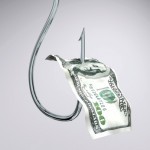![Default is Inevitable, Part II]()
by Steven Waechter | Jul 26, 2011
 Talking points are truly amazing things. They capture the essence of the obsessions of political operatives. The political news has recently been dominated by the talking points surrounding the debt ceiling debate, with the main terms of choice being the assorted variants of “apocalypse.â€
Talking points are truly amazing things. They capture the essence of the obsessions of political operatives. The political news has recently been dominated by the talking points surrounding the debt ceiling debate, with the main terms of choice being the assorted variants of “apocalypse.â€
First of all, failing to raise the debt ceiling would not automatically lead to a default on the national debt. The federal government would continue to collect revenue, and could use that revenue to pay debt obligations as they fall due, or in other words, pay the coupon interest on time. This would involve deep cuts to everything else, and if you are a professional politician that is synonymous with impossible, so there is an assumption that default would be the result.
And that default would be “apocalyptic,†“a catastrophe,†“a disaster,†or would “cost us our credit rating,†– which is doomed anyway because it is a mirage; the federal government is borrowing 40% of the money it spends this year and is projected to do so for the next ten. This is not a debtor worthy of a AAA rating, and the only reason we haven’t seen a failed bond auction is because the Federal Reserve has been buying everything in sight.
Professional politicians who never saw a dollar belonging to somebody else that they wouldn’t spend, now lecture us on the importance of borrowing money to pay the obligations on the money they borrowed to spend on political goodies. We are told of the need to increase our debts to stay current on our debt payments.
When individuals pay debts with new debts (called “Surfing†by finance experts) it is usually the last desperate trick before they call a bankruptcy lawyer. When our political overlords do it, they demand to be: 1. Re-elected; 2. Paid more; 3. Given a medal or an honorary Ivy League doctorate.
The apocalypse for the Democrats is that this issue is coming to a head too soon. Over the next ten years, a majority of the baby-boom generation will be enrolled in Social Security and Medicare. And, as the American economy continues to die over the next ten years, it is thought that these voters will be more frightened of losing benefits than of the country collapsing under the weight of the debt. Government dependency is the Democratic Party’s stock-in-trade, and they will be there to defend all government spending with borrowed (or more likely, printed) money.
In their calculation, if they can only delay the eventual tipping point where the economy just can’t take more debt, then as things continue to get worse more voters will fear losing Big Government than losing everything to Big Government.
While we’re talking about Medicare, some time soon you should do a web search for “unemployed college graduates,†and see how many news articles you can find. Think about this: A generation wants to get government-financed benefits, while a younger generation is chronically underemployed and not paying much money in FICA (Federal Insurance Contributions Act), the tax that funds Medicare. No job means no wages; no wages means no FICA; no FICA means no Medicare – unless they print the money and finance it with pure, un-tempered inflation.
The professional politicians cannot get us out of this problem; it is in their best interest to make the problem bigger. The cynicism is downright psychopathic – make sure that so many people depend on your appropriations that you cannot lose power even if the country is completely bankrupted. This, I fear, is what most Congressional Democrats, and probably most Congressional Republicans, intend to do.
It must stop. It is time to stop rewarding politicians who successfully loot the public treasury by affixing their names to schools, institutes, nature trails and wildlife refuges as recognition of their long and illustrious careers of running the nation into serfdom.
I’ve been told that veteran bankruptcy lawyers have a common speech they give to their clients who feel guilty or ashamed about the debts they’ve run up. They say “Stop that. Do you think corporate CEO’s feel guilty when they restructure debt? No! You are Mr. and Mrs. X, Incorporated, and you are getting out of debt.â€
We need to put down the pride, the guilt, and the illusions of prosperity fashioned by self-interested politicians, and declare that we are the United States of America, Incorporated, and we are getting out of debt. If we don’t, we will default eventually anyway either directly or through currency devaluation, but by then our nation will not have a future. At all.
[Note: The first article “On National Debt, Default is Inevitable,†the numbers in the article were from the Monthly Statement of the Public Debt, June 2011, but the link inside the article was to the Monthly Statement of the Public Debt from June 2010. Apologies for the error.]
Photo Becky Stares – Fotolia.com



![Default is Inevitable, Part II]()
by | Jul 22, 2011
 The following is the second installment of a two part piece. The first is entitled “The Stench of Impropriety: Tom Harkin, Al Franken, Herbalife International, and The F.R.E.E.D Actâ€, and can be viewed below.
The following is the second installment of a two part piece. The first is entitled “The Stench of Impropriety: Tom Harkin, Al Franken, Herbalife International, and The F.R.E.E.D Actâ€, and can be viewed below.
In part one of this piece, I introduced you to the relationship between Tom Harkin and his largest campaign contributor, Herbalife International. A partnership that demonstrates the perils of an incestuous system of politics and money, and ultimately played a part in Harkin’s introduction of the F.R.E.E.D. Act in the U.S. Senate. As bad as that looks, what the bill actually proposes to do is just as bad.
The act itself is only impressive in that it manages to hit the Liberal trifecta—it is completely devoid of any traditionally rational Constitutional basis, it increases and empowers an unelected bureaucracy to spend our money, and is a blatant attempt to further grow the entitlement base (which we can’t afford as it is now).
As the name suggests the stated mission of the bill is “to enhance and further research into the prevention and treatment of eating disorders, and for other purposesâ€. The bill opens with an assortment of claims and statistics meant to spur the reader into supporting its “heroic†intentions. Included here is that, “estimates, based on current research, indicate that at least 5,000,000 people in the U.S suffer from eating disorders including anorexia nervosa, bulimia nervosa, binge eating disorder, and eating disorders not otherwise specified†and “anecdotal evidence suggests that as many as 11,000,000 people in the U.S, including 1,000,000 males, may also suffer from these disordersâ€.
Naturally, the way this legislation would solve this problem is to create more agencies, throw an undisclosed amount of money around, and as mentioned above, amend and expand the Social Security Act of 1935 to ensure that we as taxpayers pay as much as possible in curing our fellow citizens’ ills.
The additional bureaucracy it proposes creating would exist inside The Department of Health and Human Services and be named—I kid you not—“The Interagency Eating Disorder Councilâ€, and be funded from 2012 through 2016. To run this Council and to award grants (i.e. our tax dollars) would be the Director of The National Institute of Health, Francis S. Collins. His job would be to hand out money, as he saw fit, to various non-profits, colleges, State or local health departments, and community based organizations.
The bill states that the grant money is to be awarded for, among other things, the following reasons: to conduct a study regarding the economic costs of eating disorders that would “examine years of productive life lost, missed days of work, reduced work productivity, costs of mental health treatment, costs to family, and costs to society as a result of eating disordersâ€. In addition, money would also be required to go to “promoting positive body image development, positive self-esteem development, life skills that take into account cultural and developmental issues and the role of family, school, communities and the connection between emotional and physical health, and the prevention of bullying based on body size, shape, and weight.â€
In short it is an embodiment of the kind of financially irresponsible, Constitution-shredding, emotionally-driven, nanny-state legislation that modern day American liberals have become synonymous with.
When it comes to co-sponsor Sen. Franken, though Herbalife did throw him $250, my sense is that he is in it for the pure ideological benefit of expanding the entitlement base…otherwise known as Section 938 of the F.R.E.E.D Act.
Section 938 is entitled “Grants to Support Patient Advocacyâ€, and would essentially require an unspecified amount of our tax dollars to be spent “diagnosing†people with eating disorders and enrolling them in Federal programs. In the bills words, the funds would be spent to “provide education and outreach in community settings regarding eating disorders and associated health problems, especially among low-income, minority, and medically underserved populationsâ€, (Sect. 938(c)(1)); “providing education and outreach regarding enrollment in health insurance, including enrollment in Medicare, Medicaid, and the Children’s Health Insurance Program (SCHIP)â€, (Sect. 938(c)(6)); and for, “Identifying, referring, and enrolling underserved populations in the appropriate Health Care agencies and community based programs and organizations in order to increase access to high quality health care servicesâ€, (Sect. 938(c)(6)).
It has long been believed by liberals that the surest way to get to a single payer health care system is to get enough people dependent on the government for this service that the private insurance sector can no longer exist. My view is that Sen. Franken (and probably Sen. Klobuchar and Sen. Harkin) wrote this part of the bill to hasten this process by further adding to the 16 million people that Obamacare is already slated to dump into Medicaid in the coming years.
Indeed this bill has a little something for everyone. The citizens among us deemed to have an eating disorder would get free medical attention, Herbalife International would be eligible to bill the Federal government for weight loss and eating disorder “treatmentsâ€, Al Franken could successfully move us one step closer to socialized medicine, and Harkin, well he has already gained $137,916 in campaign contributions (no matter the ultimate fate of the bill).
Those left among us who still respect the Constitution and its clear vision of the role of Federal government know that somewhere along the way we have failed it. Every single element of this bill, from the spirit in which it was offered, the language it contains, and the system it arose from is the epitome of this failure. I would argue that not only does this bill need to be stopped, but the institutionalized system of political donations from private companies needs to be abolished. Until such reform comes there will be no reprieve to the endless wave of disastrous special interest legislation that this bill represents.
It is we the American people that need to be F.R.E.E.D.



![Default is Inevitable, Part II]()
by John Bloom | Jul 21, 2011
 The Des Moines Register’s Opinion Section on Sunday, July 3, 2011 featured a “Progressives Trifecta†of half-truths and sophistry:
The Des Moines Register’s Opinion Section on Sunday, July 3, 2011 featured a “Progressives Trifecta†of half-truths and sophistry:
Richard Doak – What if the founders were around today?
Donald Kaul – My favorite 4th of July speech
Dean Baker – Keep Social Security safe from politicians who want to save it
This week I will focus my comments on Dean Baker’s article sub-titled “Real patriotism requires coming to terms with the grimmer side of American historyâ€. Mr. Baker is co-director for the Center for Economic Policy Research (CEPR). The CEPR home page lists 10 funders, mostly far left organizations including the Open Society Foundations, which was founded by and led by George Soros.
Dean Baker-He advises the reader that two thirds of people age 65 rely on Social Security for more than half their income. He notes that “with traditional pensions disappearing and many near retirees losing much or all of the equity in their home, and also seeing 401(k) assets plummetâ€, hence “the next generation is likely to be even more dependent on Social Securityâ€. He then proceeds to explain “Fortunately the program (Social Security) is fundamentally solidâ€. He goes on to summarize various facts about the trust fund and speculates about various ways to further improve the long term health of the program. He says “Many opponents of Social Security insist that its $2.6 trillion trust fund does not exist or that it is “just sheets of paperâ€. He acknowledges that “the trust fund is held in the form of U.S. government bonds, which are indeed sheets of paper. However, investors everywhere eagerly seek out these ‘sheets of paper’ as the safest asset in the worldâ€.
- Public reliance on Social Security-Mr. Baker is not providing a fully accurate picture in his description of the American public’s dependence on Social Security. I checked several sources for my information and found them to be relatively consistent, so I have only referenced three of them. My conclusion is that Americans who have lived within their means, saved money, invested prudently and maintained marketable skills are relying properly on Social Security as a meaningful component of their retirement. Social Security was never intended to be more than that.
- Average U.S. Home Prices[1]
- The median price of homes in the United States in 2004 was $221,000. It peaked in 2007 at $247,900. In 2010 it was $221,800. Baker’s statement about near retirees losing much or all of their equity would only have occurred if they leveraged their home equity for other reasons. If they had been in their home for 20 years, even the depressed 2010 prices reflect a gain of 80%.
Planning to Retire by Emily Brandon[2].
- Americans age 65 and older receive most of their income from four sources: employment, Social Security, pensions, and asset returns, according to a recent Congressional Research Service report. The prevalence of each of these types of income has shifted somewhat since 1980. More Americans now continue working past age 65 and fewer people bring in income from assets. Here’s a look at how the biggest sources of retirement income have changed over the past 30 years.
- Employment. In the 1980s and 90s about 16 percent of seniors worked, a number that steadily increased to 20 percent in 2008. Earnings now make up over a quarter (26 percent) of income for Americans age 65 and older, with the typical senior bringing in a median of $20,000 annually from work.
- Social Security. Social Security remains the most common source of income for people age 65 and older. About 86 percent of seniors receive these monthly checks for a median of $12,437 annually. This entitlement makes up 39 percent of the typical senior’s income.
- Asset income. Just about half of Americans (54 percent) receive some income from assets, down from 67 percent in 1980. But most Americans don’t receive very much in the form of interest, dividends, rent, or royalty payments. Interest rates and dividend yields have fallen since the early 1990s. The typical American made just $1,054 off their assets in 2008. Asset returns account for approximately 13 percent of retiree income, down from 24 percent in 1990. (Writer’s note: The Federal Reserve is “saving the economy” with 0% interest rates. Unfortunately this punishes millions of retirees who saved for their retirement and were counting on fair returns on bank deposits, CD’s etc..)
- Pensions. The proportion of Americans with a pension from a former employer has fallen slightly from 37 in 1990 to 34 percent in 2008. Pensions payout a median of $10,800 annually which makes up about 20 percent of the typical retiree’s budget.
401K Balances Moving Back to Pre-recession levels by David Pitt[3]
- Americans who were afraid to open their 401(k) statements during the recession are finding good news inside the envelope now: For the most part, their accounts have come all the way back and then some.
- Nine in 10 of the popular retirement plans are at least back to where they were in October 2007, the peak of the stock market. Since the bull market began in March 2009, stocks have almost doubled.
- And many investors who kept their nerve and continued putting some of their paycheck into a 401(k) during the market’s worst months are now ahead.
My main issue with Mr. Baker is his insistence that the Social Security Trust Fund is secure. The current crisis over the debt ceiling now exposes that lie completely. President Obama has admitted that checks may not be issued if the U.S. Treasury cannot continue to borrow next month. If the Social Security Trust Fund held real assets, rather than government paper, they could sell those assets and pay benefits independently from the General Fund. As noted above, long term investments in real estate, stocks, bonds, commodities (gold), etc. have real value. Unfortunately all we have is paper made worthless by closet socialists like Tom Harkin and Barack Obama. I wish this were not true. I have paid into these programs at maximum levels for most of my working career. Privatize Social Security? Absolutely. Young people should demand it. The Ponzi scheme is over!
I refer you to the following article, The Fraud of the Social Security ‘Trust Fund’ Exposed by a Most Unlikely Source by Don Boudreaux on July 16, 2011[4]
If Americans choose to accept the misinformation of socialists like Mr. Baker as fact, then they deserve the government and fate that they choose. The Republicans have proposed a plan and until President Obama does likewise, they should be applauded for at least recognizing the problems. Mr. Baker knows better. He is simply a socialist who hopes to use the budget crisis to tax the private sector out of business, redistribute an ever shrinking American economic pie, and secure power for global elites like George Soros.
[2] U.S. News and World Report, January 12, 2010
[3] The Huffington Post, March 21, 2011
[4] http://cafehayek.com/2011/07/the-fraud-of-the-social-security-trust-fund-exposed-by-a-most-unlikely-source.html
Photo: Gino Santa Maria – Fotolia.com

by Steven Waechter | Jul 1, 2011
 Much attention has been focused on the size of the national debt as a whole; roughly $14.4 trillion. That number is astonishing, but the sheer size of the debt actually hides the true horror which is in store for the economy and future generations.
Much attention has been focused on the size of the national debt as a whole; roughly $14.4 trillion. That number is astonishing, but the sheer size of the debt actually hides the true horror which is in store for the economy and future generations.
The debt has many component categories, the largest of which is called Marketable Debt. That means the portion of the debt that was issued in treasury securities that can be sold in the secondary bond market, and it is around $9.2 trillion. The rest is Non-marketable, and held mainly by the Social Security Administration through bonds that cannot be sold.
The Marketable Debt also has its own sub-components, based on the type of security that was sold to incur the debt in the first place. Treasury Bills mature in 1 year or less and accrue interest; Treasury Notes mature in 2, 3, 5, 7 or 10 years, and Bonds mature in 30 years – and the Notes and Bonds pay coupon interest every six months. Each bond is sold at the prevailing interest rate at the time of the sale.
Here is the part that is frightening: Starting under President Clinton, expanding under Bush, and exploding under Obama, the federal government has shifted its borrowing from traditional 30-year Bonds to the shorter term securities.
According to the US Department of the Treasury’s Monthly Statement of Public Debt dated May 31, 2011, of the $9.2 trillion dollars of Marketable Debt, only about $965 billion are 30-year Bonds. More than $6 trillion are on Notes, with maturities ranging from 2 to 10 years, and a whopping $1.5 trillion are on 1-year Bills.
We are running record deficits, so we aren’t paying any of these off when they mature – we just roll them over onto new securities. We’re also adding another $1.6 trillion on to the pile.
Right now the Federal Reserve is fixing interest rates at levels so low that they cannot be maintained forever. When the Fed raised interest rates to more than 20% back in the 1979-82 recession, the Treasury actually sold some bonds at interest rates of 20% or higher. Imagine if interest rates went up to just 10% today, and stayed there for a couple of years. All of those Bills and Notes that mature and are rolled over will roll over to higher interest rates.
The interest payments alone will easily top $700 billion dollars a year, and since the debt is likely to grow further as interest rates go up, the country is likely to pay well over $1 trillion per year in coupon interest alone -which will be financed by the issuance of new Treasury Notes.
Imagine a world where the Army is disbanded, Medicare covers only critical care needs, the Social Security age is retroactively raised to 75, and the all retired government officials lose their pensions because the United States needs to dedicate so much of its budget to paying the interest on the debt. These are politically impossible measures.
The only other way to avoid direct default is to print money – destroying the nation’s economy with hyperinflation but technically making the interest payments, albeit with dollars devalued to near worthlessness. That’s how the Federal Reserve managed to keep interest rates so low up to this point – by buying Treasuries at artificially low interest rates with printed money. That is why Bill Gross of PIMCO dumped every piece of US Treasury paper his hedge fund owned – the returns on these bonds would have been eaten up by inflation.
There it is – either we ruin the dollar or we default. Default is by far the better option; we can restructure our debts to something more manageable. This will ruin our credit rating forever, so future politicians will not be able to run deficits for vote-buying projects and illegal “Kinetic Military Actions,†whatever those are. There are silver linings everywhere.
![Default is Inevitable, Part II]()
by Brian Nygaard | Jun 7, 2011
 It was a steamy 98 degrees in Atlanta. It was clearly too hot for me to be out running at the local high school track…but there I was. I was not alone, however. Occupying Lane 4 was a guy who I would guess was born somewhere immediately after WWII. But my track-mates age was not the interesting part of the story. The interesting fact was that the man was clad in a long-sleeved sweatshirt. Yes, and it even had a Nike SWOOSH on it. I thought to sweaty self, “This has to be the most bizarre thing I have seen all week!†However, upon a few moments of reflection, I concluded it wasn’t even close to the top of the Week’s-Most-Bizarre List.
It was a steamy 98 degrees in Atlanta. It was clearly too hot for me to be out running at the local high school track…but there I was. I was not alone, however. Occupying Lane 4 was a guy who I would guess was born somewhere immediately after WWII. But my track-mates age was not the interesting part of the story. The interesting fact was that the man was clad in a long-sleeved sweatshirt. Yes, and it even had a Nike SWOOSH on it. I thought to sweaty self, “This has to be the most bizarre thing I have seen all week!†However, upon a few moments of reflection, I concluded it wasn’t even close to the top of the Week’s-Most-Bizarre List.
My first cataloguing thought was that the Massachusetts tornado was the most bizarre thing that happened this week; but I concluded it only scored 8.0 on the 10 point scale. After all, the weather has been crazy this year. Then it occurred to me that “Weinergate†was about as weird as it gets. And it did involve the Honorable US Representative Anthony Weiner from New York…making it a natural candidate, by definition.  Many of us would have been more comforted by simply hearing him say “That is not mine.†as opposed to “It was pranksters.†But even allowing for a couple of additional Anthony Wiener style points, he only merited 9.0 on the Bizarre Scale.
I then gave passing consideration to Barack Obama’s honoring of our fallen war heroes with an “18 flag tribute†at the local golf club on Memorial Day. And that might have been a winner had the event in any way stuck out from his normal complete lack of respect for people who actually believe in what America stands for. While scoring an impressive 9.5, the President’s behavior still fell short of this week’s winner.
The winner for the most bizarre thing that happened this week, with a score of 9.7, was Clinton’s former Secretary of Labor, Professor Robert Reich, from (of all bizarre places) Cal Berkeley.
In an article in (of all bizarre places) the San Francisco Chronicle, he is quoted:
In response to slow economic growth: “Right now we need more public spending in order to get people back to work. And we need a new Works Progress Administration to get the long-term unemployed back to work.â€
In response to declining home prices: “That means most Americans have to save big-time if they’re going to be able to retire or even send the kids to college. As a result, consumer spending will stay anemic and unemployment will remain high – unless Washington fills the gap.â€
And he teaches our children this stuff…
So if the federal government is currently spending $1.5 trillion more than it receives (an annual deficit representing nearly ten percent of the entire economy), that is not enough government stimuli? What amount might be enough, Mr. Reich? (In the good professor’s defense, he does likely make the highly nuanced distinction between normal unproductive and wasteful federal government spending and targeted unproductive and wasteful federal government spending.)
And what gap is it that Washington needs to fill? I guess this assumes that irrespective of how poorly the economy is managed, and unrelated to how little money consumers have to spend, that the government can just step in and “create an economy.†Does he really not understand the notion of rational investment and the resultant productivity increases that singularly drive economic growth? Is his whole world just one very large social and political abstraction for Mr. Reich? Whatever it is, it is truly bizarre.
Apparently, this is the thinking of people like Mr. Reich: If something isn’t working, has never worked, and will very likely never work, and yet you believe in it very strongly…just do more of it. If you do not find yourself tortured enough by running outdoors in temperatures of nearly 100 degrees, slap on a sweatshirt! The underlying logic embedded in both of these scenarios is both beautifully and brutally consistent.
For his remarkable jeremiad, Professor Reich is credited with a score of 9.7, and is the winner of the “Most Bizarre Thing of the Week†Award. Well done, and congratulations, Bob!



Page 4 of 6« First«...23456»
 Talking points are truly amazing things. They capture the essence of the obsessions of political operatives. The political news has recently been dominated by the talking points surrounding the debt ceiling debate, with the main terms of choice being the assorted variants of “apocalypse.â€
Talking points are truly amazing things. They capture the essence of the obsessions of political operatives. The political news has recently been dominated by the talking points surrounding the debt ceiling debate, with the main terms of choice being the assorted variants of “apocalypse.â€



